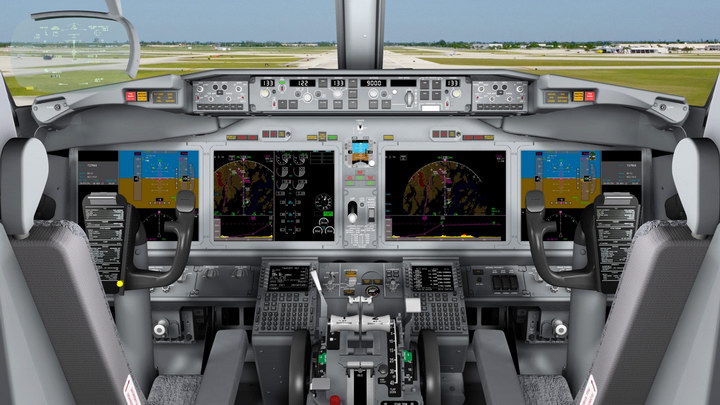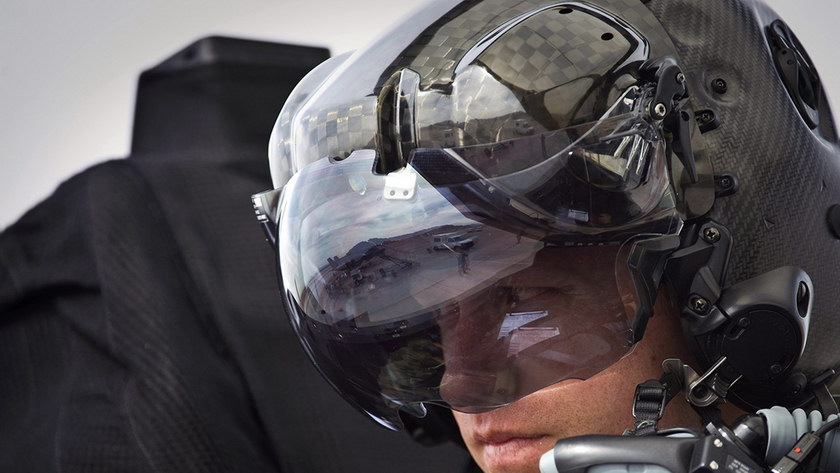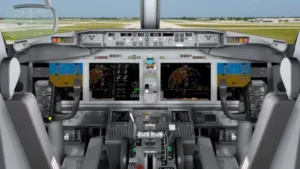Most modern aircraft have “glass cockpits”, which means that the conventional electrical, mechanical and vacuum instruments are replaced by LCD screens driven by computer systems. For example, the 737 Max had its first test flight on January 29, 2016 with deliveries starting in 2017. This aircraft had a glass cockpit developed by Rockwell-Collins consisting of four main 15” LCD displays, as can be seen in the image below.

 Glass cockpit of the Boeing 737 Max Aircraft. The see-through, Head Up Display for the Captain in the left seat is visible in the upper left corner. In the similar 787 cockpit, HUDs are provided for both pilots. (Credit: Boeing)
Glass cockpit of the Boeing 737 Max Aircraft. The see-through, Head Up Display for the Captain in the left seat is visible in the upper left corner. In the similar 787 cockpit, HUDs are provided for both pilots. (Credit: Boeing)
Essentially all modern commercial and military aircraft have glass cockpits, perhaps with a few traditional back-up instruments. More commonly, however, even the back-up instruments in modern aircraft are also electronic with LCD displays. These back-up systems are electronically independent of the primary instruments and typically have several hours of battery back-up, allowing safe landings in case of a failure of the primary flight control and display system.
Electronic displays have several advantages over traditional flight instruments. One of the big advantages is cost savings. With all information about the airplane available at the pilot’s fingertips, the flight engineer with his giant bank of conventional displays showing engine RPM, fuel flow, temperatures, etc. for each of four engines is no longer needed and most modern planes can be flown by a two-person crew. This not only eliminates the cost of the flight engineer, but it frees up weight and space for more passengers, cargo and/or fuel in the airplane.
Early glass cockpits were based on CRTs, which were heavy and bulky. According to Boeing, when you upgrade your 757/767 from the original CRT-based cockpit to a LCD glass cockpit similar to the one in the 737 Max or the 787 Dreamliner, you save 150 pounds (68 KG) in weight. Over the life of a commercial airplane, carrying an extra 150 pounds around for millions of miles can result in significant extra fuel consumption. In addition, the similarity of the 737 and 787 displays to the upgraded 757/767 displays simplifies pilot transition training.
 AOA indicator and Disagree Warning in a 737 Max Glass cockpit (Credit: Boeing)
AOA indicator and Disagree Warning in a 737 Max Glass cockpit (Credit: Boeing)
On the other hand, glass cockpits have disadvantages as well. Nothing is a better warning for a pilot than a flashing red light. The warning for AOA Disagree problem (I.e. the two angle of attack (AOA) sensors give different readings, if the aircraft is equipped with redundant sensors) in the 737 Max is a modest, low-contrast signal in one corner of a display. An AOA failure in the 737 Max can activate the Manoeuvring Characteristics Augmentation System (MCAS) which, in turn, could crash the airplane within seconds if the plane is at low altitude such as on take-off.
 The glass cockpit in the F-35 simulator is virtually identical to the unit in the aircraft itself (Credit: Lockheed-Martin)
The glass cockpit in the F-35 simulator is virtually identical to the unit in the aircraft itself (Credit: Lockheed-Martin)
The F-35 from Lockheed-Martin is the latest fighter aircraft in the US inventory. Like all modern aircraft, the F-35 has a glass cockpit. There is one thing most modern military and commercial aircraft have, however, that is missing in the F-35: a head-up display (HUD). Fighter planes, in particular, have had HUDs to display weapon targeting information to the pilot without the need for him to lose visual contact with the target for many years. The reflector sight was a head-up, see-through device developed before World War 2 to provide pilots with an aim point for their guns. The first true HUD was in installed in 1958 in the British Buccaneer attack aircraft. Since then, HUDs have moved from military aircraft to commercial aircraft and into automobiles.
 Helmet mounted bi-ocular see-through AR system replaces the conventional HUD in an F-35. (Credit: Rockwell-Collins)
Helmet mounted bi-ocular see-through AR system replaces the conventional HUD in an F-35. (Credit: Rockwell-Collins)
The F-35 is the exception and has no HUD. Instead, it is equipped with a virtual HUD in the form of a see-through helmet mounted display (HMD) that provides the pilot with all the information of a conventional HUD plus much more. In addition to supplying targeting information and aircraft data, the HMD also serves as the display for the night vision system so the pilot does not need to switch to different helmets for day and night operations. One major addition is the display provides see-through information.
If the pilot looks down, instead of seeing his feet, he can see the image from a conventional or night-vision camera under the aircraft that shows him what is below his plane. Since some versions of the F-35 are vertical take off and landing, this allows the pilot to see what is under him during a landing. This does not come cheap – the helmet with the see-through AR display alone is estimated to cost about $400,000 and each F-35 pilot needs his own custom fitted helmet.
Glass cockpits are not just for state-of-the-art military and commercial aircraft. Glass cockpits are also common in modern private aircraft and are even available as retrofits into some older private aircraft. This will be discussed in Part 2 of this Display Daily, to be published on March 5th. -Matthew Brennesholtz

